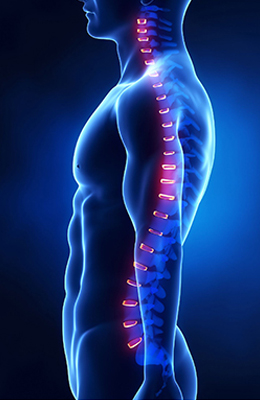Yes!! ABC TVs Good Morning America proved it on a Vimeo video. The research used the expertise of Dr. Marshall Dickholtz, Jr., a Chicago area Chiropractor, to test the effect of specific adjustments to the upper cervical spine. The study was to test the theory that adjustment could have a positive affect on blood pressure. It did!, now WHY?
The Medical Director for this University of Chicago Medical Research allowed Dr. Dickholtz to examine 50 Hospital patients. 25 received a real adjustment and 25 had fake adjustments. They each had only (1) adjustment and 8 weeks later those having the real adjustment still had lowered blood pressure. Impressive indeed!
If you watched the video you heard Dr. Timothy Johnson say that the “C1 vertebra is in a critical area” and Robin Roberts say it was like “the fuse box for the spine”. Let’s look at this a little closer.
Look at this diagram of the Central Nervous System.
 The three parts are the Motor Nerves, the part you mostly control. The Autonomic Nerves, the automatic part that you have little control over. And the smallest part, the Sensory Nerves tell you what is happening in your environment, so you can use the larger two parts to adapt.
The three parts are the Motor Nerves, the part you mostly control. The Autonomic Nerves, the automatic part that you have little control over. And the smallest part, the Sensory Nerves tell you what is happening in your environment, so you can use the larger two parts to adapt.
Each of these systems have information constantly traveling from the brain to the distant cells and then from those cells back to the brain. The Autonomic Nervous System has two parts. The Sympathetic Nervous System or accelerator and the Parasympathetic Nervous System or the brakes. The Sympathetic NS is primarily from C2, in the neck, down to L5, in the low back. These nerves overlap but are specific to each of the organs. Much as in your car, you can step on the gas (Sympathetic NS) or let up according to need. Sometimes you must slow down even faster, so you use the brake (Parasympathetic NS). If your accelerator gets stuck, you would have to brake hard.
The Sympathetic NS is more closely related to the Adrenal Gland and the Neurochemical that supports the Sympathetic NS is Adrenaline. Adrenaline causes the Sympathetic NS to speed up the heart rate, tenses muscles (which can cause diarrhea or bladder urges early on), increases blood pressure, dilates the pupils, reduces the appetite, then slows bowel and bladder functions. Many patients with high blood pressure have many of the above symptoms. Too much stimulation of the Sympathetic NS.
Why didn’t the Parasympathetic NS slow it down? That may be the answer to the WHY? C1, the vertebra Dr. Dickholtz adjusted during the research project at the University of Chicago, that is where some of the Parasympathetic NS brakes are found. If there is a Subluxation at C1 it can cause the Parasympathetic NS to not function in time with need. It could also be the culprit that is not allowing the Sympathetic NS to slow down. SOOO if the Sympathetic NS is not slowing down and the Parasympathetic NS is not stopping the rush, we have out of control Hypertension. The Parasympathetic NSslows the heart rate, relaxes the muscles, lowers the blood pressure, constricts the pupils, stimulates the appetite and normalizes the bowel and bladder . This seesaw activity is supposed to be constantly active. It requires a nervous system functioning at 100%. SOOO, How often do you think it is necessary for your nervous system to function at 100%? Once a day like a broken clock, or as close to 100% of the time 24/7?…….?……….?………..?
Of course it is still your choice just like it is your choice to see your dentist, your doctor or to mow your yard or change oil in your car. You have lived this long without a Chiropractor, why start now? Well maybe it could mean the difference between the health you have now and the health and wellness you have been seeking. After all, if you were happy with what you have you would not be reading articles written about health and Hypertension.
Think about it and give us a call at 260-747-1596. We look forward to serving you.
. . Have you heard of nattokinase? Check out the potential effects it can have on your […]
. . Do you have plantar fasciitis or heel spurs? Don’t make this huge common mistake! Find […]
.. Could the way many doctors learn how to help with plantar fasciitis be wrong? Check out […]
Foods that support health with high mineral, high detox, reduce digestion troubles. – Dr. Berg
Tony Schumacher , American drag racer and eight-time NHRA Champion suffered a terrible crash at 320 mph […]
A Chicago-area study of patients with a misaligned Atlas vertebra (located high in the neck) and high […]
Half Somersault Maneuver Benign Paroxysmal Positional Vertigo or BPPV Video: Carol Foster, MD Vertigo Treatment BPPV has […]
Yes!! ABC TVs Good Morning America proved it on a Vimeo video. The research used the expertise […]
Lecithin, as a nutritional substance, mostly comes from Soy Beans. The Vitamin Companies we use certify that […]
The old joke is, “Nothing.What has it done for me?” Actually, a fever probably has done a […]
